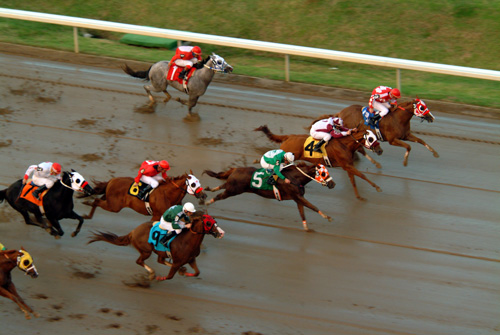The Kentucky Derby is one of my favorite spring events. It’s fun to learn how some of the horses got their unusual names and to hear the jockeys’ stories. The extravagant ladies’ hats and the pageantry add to the anticipation of what’s been called “the most exciting two minutes in sports,” when twenty horses thunder around a mile and a quarter track.
I’m not much of a gambler, but I place a small wager with my son on which horse will come in last. That horse can be harder to pick than the winner because no one says much about the unfavored; you just have the odds to look at. This year had a twist. Hard rain made this the wettest Derby in history, and wide brimmed hats (covered in plastic) actually became practical. What’s more, I found out too late to change my bet that my horse was a mudder, and so I owe my son some money.
 The rain and mud posed a problem for the jockeys, too. Most jockeys wear safety goggles, but there’s no way to clean them while going nearly 40 miles per hour on horseback. The most common solution is to wear multiple pairs of goggles so that a muddy one can quickly be pulled down with one hand to reveal a clean one. One jockey explained that in conditions like they were facing May 5, he wears six or seven pairs of goggles, and decides when to change each one, not by how dirty it is, but by how much farther he has to race. Now look at the winner, Justify, this year. That horse had the cleanest face, and jockey Mike Smith had the cleanest goggles on the field. This was one time you could tell the winner without having seen the race. The moral of the story is that if you don’t want to change goggles, you’d better win.
The rain and mud posed a problem for the jockeys, too. Most jockeys wear safety goggles, but there’s no way to clean them while going nearly 40 miles per hour on horseback. The most common solution is to wear multiple pairs of goggles so that a muddy one can quickly be pulled down with one hand to reveal a clean one. One jockey explained that in conditions like they were facing May 5, he wears six or seven pairs of goggles, and decides when to change each one, not by how dirty it is, but by how much farther he has to race. Now look at the winner, Justify, this year. That horse had the cleanest face, and jockey Mike Smith had the cleanest goggles on the field. This was one time you could tell the winner without having seen the race. The moral of the story is that if you don’t want to change goggles, you’d better win.As an ECP, one other thing caught my attention. Winning trainer Bob Baffert’s sunglasses were crooked. A close up showed clearly that the temples were either too short or not adjusted properly. With all due respect, this man trained a horse that won a $1.25 million purse, and he can’t get a pair of glasses that fits? If there’s an optician in Santa Anita Park, California, who can help Mr. Baffert, please do!
For as much as we need to know about sports glasses, we can learn from them and their wearers, too. People who wear sports glasses care about their eyes and about their sports, and each sport has its own particular demands. That’s where we come in to make the best recommendations for safety and performance. You’ll find great information about how to enhance your patients’ outdoor sports experience in our CE Upping Your Game: Taking Outdoor Sport Eyewear to the Next Level, Part 1 at www.2020mag.com/ce.













